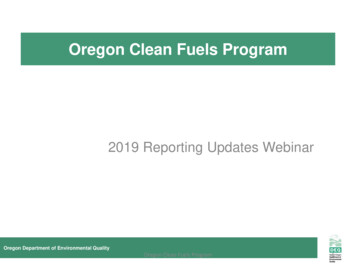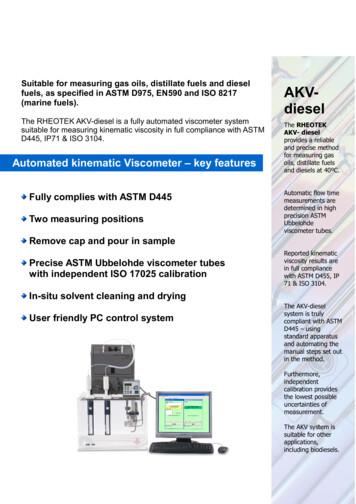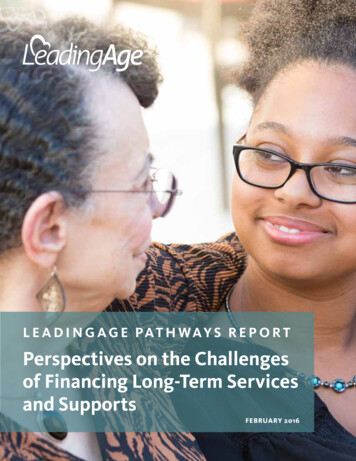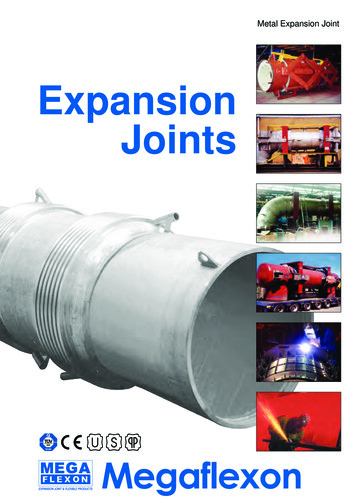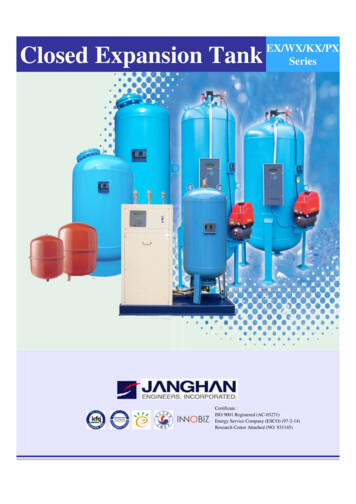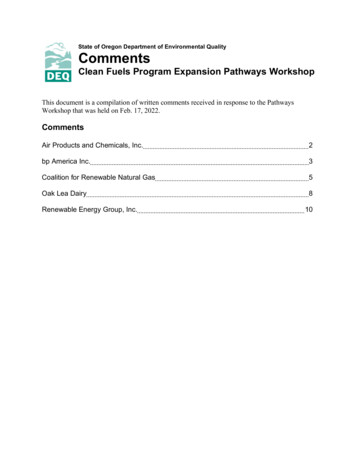
Transcription
State of Oregon Department of Environmental QualityCommentsClean Fuels Program Expansion Pathways WorkshopThis document is a compilation of written comments received in response to the PathwaysWorkshop that was held on Feb. 17, 2022.CommentsAir Products and Chemicals, Inc.2bp America Inc.3Coalition for Renewable Natural Gas5Oak Lea Dairy8Renewable Energy Group, Inc.10
From:To:Subject:Date:Heller,Miles T.WIND Cory Ann * DEQ; PETERS Bill N * DEQFeedback regarding H2 book & claimThursday, February 17, 2022 2:21:07 PMCory Ann/Bill – Apologize that I cannot offer comments live on the webinar. It is really noisy here –though I am able to hear most of the webinar. As we stated in formal comment letters, we aresupportive of the flexibility that these provisions would provide. Below is some feedback on thespecific questions you asked in the webinar. Happy to answer questions or set a call to discuss.1. What projects or producers would potentially benefit from this allowance of book and claimfor hydrogen?Providing an environmental attribute tracking system could benefit both hydrogen used directlyin transportation (i.e., FCVs) and hydrogen used as a feedstock for renewable diesel production.If the Oregon CFP had provisions like CARB’s refinery investment credit provisions or refineryrenewable hydrogen provisions, this methodology could enable reductions for refineries too.However, I do not believe that the Oregon CFP includes provisions like these. Perhaps, to theextent a refinery is doing coprocessing and using low carbon hydrogen for that coprocessing,then this kind of tracking system may be germane for a project like that.2. For hydrogen used in renewable diesel production, is an attestation-based book and claimaccounting option for hydrogen produced from non-fossil resources reasonable so long as it islimited to a hydrogen-only delivery system with multiple sources of hydrogen? Does it provideassurance/prevent against source swapping, other? Why or why not?I need to give this more thought, but I think this type of system could work. It is not really thatthe low carbon environmental attributes are ‘separated’ from the hydrogen molecule like insome of the other book & claim provisions you reference. It is more that the low carbon H2 iscomingled with higher carbon H2 and we would want to be able to specify the low carbonhydrogen to specific end users. It is a little more like mixing bio feedstocks or biofuels andtracking the CI. One item to emphasize is that the delivery system referenced could be adedicated H2 pipeline or vessel/train/truck.3. How do we prevent potential double counting?I think that reported low carbon hydrogen production via approved pathway, coupled withreported use in the CFP program, along with transport/transfer records and verified by anindependent verifier is sufficient.4. Should the low-CI hydrogen producer apply as a joint applicant with the fuel productionfacility?Need to give this more thought – just would not want this to be too limiting or administrativelycumbersome. I envision central low carbon hydrogen facilities that might serve multiple endusers through these commingled systems. I would think that the hydrogen producer would wantthe flexibility to certify the hydrogen pathway independently and then provide to different userswith proper transfer documentation – as opposed to having to jointly apply with each end user.In this case the end-users would have to incorporate the approved CI or CIs from a hydrogenproducer(s) into their pathway. Maybe it is best to allow for both arrangements.Miles HellerAir Products and Chemicals, Inc.Director, Greenhouse Gas Government Policy
Mark BunchRegulatory AdvisorC&P – Fuel supply & midstream: biofuel & low carbonbp America Inc.30 S. Wacker DriveChicago, IL 60606March 4, 2022Oregon Department of Environment QualityVIA Email TransmissionCFP2022@deq.state.or.usRe: Oregon Clean Fuels Program Expansion 2022 Pathways Workshop Feb.17, 2022Dear Department of Environmental Quality Staff:On behalf of bp America Inc., thank you for the opportunity to participate in the Oregon Departmentof Environmental Quality’s (“DEQ”) rulemaking on the Clean Fuels Program (“CFP”) as a member ofthe Rules Advisory Committee (“RAC”).bp’s ambition is to become a net zero company by 2050 or sooner, and to help the world reach netzero, too. Consistent with bp’s ambition, we are actively advocating for policies that addressgreenhouse gas (“GHG”) emissions.For two of the workshop topics – rule language for pathways and related topics; and Green-erequirement for biogas to electricity projects – our comments are captured in the letter submitted bythe RNG Coalition, of which we are a member. Additionally, we have no specific comments toshare on the OR-GREET topic.We do have specific suggestions on the following workshop topic:Hydrogen Book-and-Claim AccountingAs we have stated in previous comment letters to DEQ in this rulemaking, bp supports the broaderadoption of book-and-claim accounting, as it enables environmental attributes to be recognizedwithout the need for the physical molecule to enter the jurisdiction to qualify. In addition tohydrogen, Renewable Natural Gas (“RNG”) also should be considered eligible for book-and-claimaccounting into clean fuel production facilities rather than be limited to direct transportation fuelapplications. We urge DEQ to adopt this approach to support meeting the program’s expansiontargets.
With respect to the questions raised during the workshop around hydrogen book-and-claim and thecomplexity of different hydrogen sources and their implications for finished fuel carbon intensities,bp would suggest that DEQ consider adopting a project-based approach to accounting for GHGreductions from hydrogen rather than a pathway approach. Section 95489(g) of the California LowCarbon Fuel Standard contains a provision for a Renewable Hydrogen Refinery Credit Pilot Program.DEQ could adopt this California LCFS concept and apply it to not only refineries, but also to cleanfuel production facilities. Taking this approach may offer a simpler way to account for GHG reductioncontributions from hydrogen than having to manage multiple pathways.Thank you for the opportunity to comment on these important topics and we look forward toworking with DEQ and key stakeholders through this rulemaking process. In the meantime, do nothesitate to reach out to me if you have any questions or need additional context.Sincerely,Mark Bunch
March 4, 2022Submitted via email to CFP.2022@deq.state.or.usCory Ann WindOregon Department of Environmental Quality700 NE Multnomah St., Room 600Portland, OR 97232-4100RE: Oregon Clean Fuels Program Expansion 2022 – Comments on Pathways WorkshopDear Ms. Wind,The Coalition for Renewable Natural Gas (RNG Coalition) 1 submits these comments in response to thepublic workshop on pathways hosted on February 17, 2022 by the Oregon Department of EnvironmentalQuality (DEQ).2 The workshop was organized in the context of the Clean Fuels Program (CFP) Expansion2022 Rulemaking.About the RNG CoalitionThe RNG Coalition is the trade association for the RNG industry in the United States and Canada. Ourdiverse membership is comprised of leading companies across the RNG supply chain, including recyclingand waste management companies, renewable energy project developers, engineers, financiers,investors, organized labor, manufacturers, technology and service providers, gas and power marketers,gas and power transporters, transportation fleets, fueling stations, law firms, environmental advocates,research organizations, municipalities, universities, and utilities. Together we advocate for thesustainable development, deployment, and utilization of RNG, so that present and future generationshave access to domestic, renewable, clean fuel and energy in Oregon and across North America.Eligibility of Biogas to Electricity Projects Should Be Extended Indefinitely or the Goals of Conversionto RNG Should Be More Clearly ArticulatedAt the public workshop, DEQ discussed Green-e “new date” requirements for biogas to electricityprojects. We believe that Green-e established a sunset of the crediting period for biogas facilities withthe assumption that once a project had paid off its capital costs3 it would no longer need continuedsupport to keep operating. RNG Coalition disagrees with this logic because such projects have ongoingoperating and maintenance (O&M) costs4 that need to be covered to keep capturing and convertingmethane into useful energy for the transportation sector. If such facilities do not have the ability to1For more information see: http://www.rngcoalition.com/2Presentation slides: p2022PathwaysWorkshop.pdfWorkshop memo: p2022owmemo.pdf3In part due to policy support during the 15-year crediting window.4The following analysis from the IEA gives some sense of the ratio between capital and operating/maintenancecosts for biogas projects globally. The economics of individual Oregon projects likely vary significantly from thesegeneralized global values. it-of-energy-produced-excluding-feedstock-20181
cover their operating costs, they will likely retire early or be mothballed. That situation could result in areturn to venting the biogas, which would be a step backward in Oregon’s efforts to control methaneemissions.At the Workshop DEQ staff also mentioned the eight Green-e conditions to reset the eligibility of biogasto electricity projects. RNG Coalition believes that relying on these conditions as the only method toextend crediting eligibility may create a perverse incentive to rebuild a digester or major powergeneration equipment even if such a repower is not needed. Reconstructing major pieces of equipmentyears ahead of the natural end-of-life increases net global greenhouse gases due to the additionalemissions that occur during accelerated equipment manufacturing.We understand DEQ’s objective of incentivizing the commissioning of new projects to contribute tocarbon intensity reduction targets and, potentially, to promote continued efficiency improvement inpower generation equipment through repowering. Our perspective is that additional reductions will beachieved via the increase of the carbon intensity reduction target5 and not by rendering ineligible plantsthat are already contributing to achieving current targets in the CFP. Biogas to electricity projectsshould be allowed to participate beyond 15 years and receive a level of crediting that is at leastsufficient to cover ongoing O&M costs.If the DEQ’s goal with the sunset is to eventually convert a large amount of the current biogas-toelectricity projects to pipeline injection projects (RNG) this goal should be more clearly articulated.6 Wecan understand the benefits of promoting pipeline injection, where viable. However, pipeline injectionis not necessarily the best fit for all projects, especially for those that are far from the existing gasinfrastructure. Similarly, if the goal is to drive increased efficiency in power generation equipment overtime, DEQ should explicitly state this and allow project developers to explain what efficiency levels arecurrently achievable at such projects from various technologies, their relative costs, and a path tocontinued efficiency improvements in the future.Adding Flexibility for Accounting of Hydrogen and Renewable Natural Gas is HelpfulWe support the additional flexibility in book-and-claim accounting discussed at the workshop for bothhydrogen and RNG as an input into making liquid fuels.We continue to recommend reliance on a national registry for tracking RNG production and end use.Such a system will become especially important as the number of RNG projects reaches into the highhundreds7 or thousands. The leading registry system tracking RNG, and other forms of renewablethermal energy, is the Midwest Renewable Energy Tracking System (M-RETS).8 The use of M-RETS to5As currently planned by DEQ in this rulemaking.6To some extent, the existing "adjustment factor" that is used in biogas-derived electricity prioritizes pipelineinjection where feasible. While the RNG Coalition neither explicitly supports or opposes the use of this factor wedo recommend DEQ further clarify its goals with respect to best use of the biogas resource and how suchadjustments impact incentives to choose various end uses.7There are now 249 operational RNG projects in North America, with another 223 in construction or planned. s.org/m-rets-renewable-thermal-tracking-system/2
supplement CFP reporting would reduce administrative burden on DEQ staff and offer Oregon a chanceto harmonize the design of such systems with other RNG-supportive policies.9We believe that existing hydrogen pipeline networks are relatively limited and, therefore, tracking thehydrogen from source to end use will likely be a comparably simple exercise, and an attestation-basedsystem should be sufficient protection from double claims in the near term. If the network for hydrogenpipelines expands, M-RETS will likely also expand to incorporate such tracking.Adding a Tier 1 Calculator for Biogas to Electricity Pathways Would Provide Helpful ClarityThe Workshop included a discussion of development of a Tier 1 simplified CI calculator for biogas toelectricity pathways, based on the current simplified calculator for biomethane from anaerobic digestionof dairy and swine manure. We support electricity as an end use being incorporated into all Tier 1biomethane calculators.ConclusionRNG Coalition appreciates the opportunity to participate in RAC and public meetings and providecomments in this process. We thank DEQ for their continued leadership on this program. We lookforward to participating in the next steps of the 2022 Expansion Rulemaking and are confident that theresults of the rulemaking will strengthen the CFP as a model that other jurisdictions will review andreplicate.Sincerely,/s/Sam WadeDirector of State Regulatory AffairsCoalition for Renewable Natural Gas1017 L Street #513Sacramento, CA 958149For example, Oregon has already approved the use of M-RETS for tracking RNG purchases by gas utilities. 0-227.pdf Following Oregon’s example, California recentlyendorsed the use of the M-RETS system in RNG procurement by gas utilities. ed/G000/M454/K335/454335009.PDF3
Statement for the CFP Expansion Rulemaking – Pathways Workshop on February 17, 2022My name is Tim Bielenberg, owner of Oak Lea Dairy in Aumsville, Oregon which I started in1974. We’re a family-owned business that milks about 450 dairy cows and sells the milk to alocal and family-owned milk processor in Vancouver, Washington, and who then distributes ourmilk through a regional employee-owned retailer.I know the manure from our cows produces methane, which is why back in 2012 I did the rightthing by installing a digester on our farm. We were one of just three facilities to invest in thistechnology, which was new at the time and requires a dedicated plant operator, tons of timeand frankly lots of money to keep operational. Because of these issues, we’re the onlyremaining facility left operating of the three original facilities. When we took over the digester,we looked at producing RNG but it was too expensive for a small family farm like ours.We don’t just help reduce our own carbon footprint but also reduce emissions for others in ourcommunity. We receive and process brown grease from local restaurants and bars whichnormally goes to a landfill to create fugitive methane emissions. We also work with the localbiodiesel refinery out of Salem to process their wastewater, further protecting and improvinglocal water quality and creating a sustainable alternative for waste disposal in our community.One other major barrier facing our operation and others will be the renewal of Power PurchaseAgreements that were signed around 10 years ago. Originally, we were offered around 0.10per kWh but we’ll likely be lucky to get 0.03 per kWh on a new PPA when our existing PPAexpires. The Oregon Clean Fuels Program represents the only tool left available to help us keepthe digester operating, capturing and destroying harmful methane gas before it enters theatmosphere.Part of our farm’s income came from the State of Oregon through Oregon Department ofAgriculture in the form of tax credits issued based on tons of biomass put through the digester.Originally the income was 5 per ton and then it dropped to 3.50 per ton but that programended December 31,2021. It was a large part of our operating income. We are now heavilyrelying on the Clean Fuels Program to help our digester to stay operating.We’d like to see a strong policy signal from DEQ for the Clean Fuels Program to incentivizefarms like mine across Oregon to reduce methane emissions, the CFP is important for us tosupport continued operation of the digester on our small farm. The Green-e standard createsuncertainty in three ways that jeopardizes this vision of mine:1) The Green-e standard currently only allows a 15-year project life because of the NewDate. We do not anticipate being able to reset the Green-e New Date. Do you knowhow much a digester costs and what the Return on Investment is like? We’re talkingmillions of dollars on a project that actually does not pencil in today’s electricity marketenvironment.2) The Green-e standard is developed outside of the Oregon DEQ Clean Fuels Programrulemaking process. I’m busy running a small farm, it is a challenge for me to participate1
in the CFP stakeholder process, and nearly impossible for small farmers such as myselfto engage in monitoring or participating in the Green-e Standard development.3) Businesses need strong policy indicators to invest in large and complex projects such ason-farm digesters that require significant financial investment and time, especially inlight of rock-bottom PPA electricity prices. The Green-e Standard creates significantuncertainty into the future as the Standard continues to evolve independent of theClean Fuels Program Regulation.On-farm digesters such as ours at Oak Lea are one of the best tools for Oregon to fight methaneemissions while generating renewable electricity – it is low-hanging fruit. Methane is over 25xworse than carbon dioxide in terms of its global warming impact, so I would hope Oregon andDEQ strive to reduce methane emissions first wherever possible.We are updating our digester continuously so the repowering to reset the new daterequirement could cause us to replace components that may have been recently replaced. TheNew Date requirement in the Green-e Standard will prevent our project and many others fromcontinuing to capture and destroy planet-warming methane emissions and I hope DEQrecognizes the impact that this voluntary standard presents to the Oregon Clean FuelsProgram’s ability to help incentivize and catalyze methane emission reductions across Oregonfarms and existing biogas sources.Thank you.Tim BielenbergOak Lea Dairy11314 Mill Creek RD SEAumsville, OR 973252
March 4, 2022Ms. Cory Ann Wind, Clean Fuels Program ManagerOregon Department of Environmental Quality700 NE Multnomah Street, Suite 600Portland, OR 97232-4100Submitted electronicallyRE: Third Clean Fuel Program Expansion CommentsMs. Wind:Renewable Energy Group, Inc. (“REG”) reiterates our support of expanding and accelerating theClean Fuel Program (“CFP”) through this rulemaking. Growing the Oregon CFP is a significant stepforward in reducing fossil carbon emissions in Oregon. REG appreciates the opportunity to providespecific comments on the Rule Advisory Committee Meeting on January 26, 2022 and thePathways Workshop on February 17, 2022.Regarding additional documentation for credit transfers, in general, REG supports followingCARB’s approach with a few ideas for improvement on their process below.We support Types 1, 2, and 3 for credit transfers (LRT screenshot below).However, REG does not support having a log of agreements for Type 2 and Type 3 agreements.The way the CA LRT is currently designed, we need to fill out the commercial terms twice - onceRENEWABLE ENERGY GROUP416 S. Bell Ave., Ames, IA 50010 / 1 888 REG 8686 / regi.com
for the agreement and once for the actual transfer. We believe this should only be done once. Wewould recommend adding the Credit Delivery Type (single or multiple) to the transfer process aswell as the agreement termination date (LRT screenshot below). If that occurred, it would alsomake sense to add a contract identifier field for those contracts with multiple transfers to helpmarket monitoring.REG supports additional credit generation opportunities.Who would get the credits? The producer? The initial importer? Any entity that generated creditsusing that fuel pathway?REG supports a process where the producer has first rights to the credits and has the flexibility forthe producer to allow the importer to generate the credits if the producer either is not registeredor does not wish to do so.Should there be a significance threshold for this proposal? In other words, should additional creditsbe generated only if the operational CI is at least 1 gCO2e/MJ lower than the certified CI? Whatshould that threshold be?REG supports a similar methodology to the materiality threshold for pathway re-application.RENEWABLE ENERGY GROUP416 S. Bell Ave., Ames, IA 50010 / 1 888 REG 8686 / regi.com
For the second proposal, should producers not subject to verification have any ability to generateadditional credits?REG supports the additional credits being generated after 3rd party verification. This wouldeliminate the risk of a certified CI exceeding its registration between validation/certification andverification. For example, if a facility receives a certified pathway in Q2 2022 at a 50 CI (temp CIwas 65 for Q1), this facility would be allowed to retroactively generate credits for Q1 at the lowerCI after the 3rd party verification is completed in August 2023. This puts them on the same timelinefor retroactive credit generation as other pathways that have lower verified CI (e.g. a facility witha 52 CI for all 2022, but is verified at a 50 CI during 3rd party verification).Additionally, REG would like to reiterate our support for expanding the proposed compliancerequirements beyond a 25% reduction by 2035. The ICF illustrative scenarios demonstrate a 37%reduction is feasible and REG believes this conservative level of biofuel usage in the illustrationwill easily be exceeded. Please refer to our previous comments for further details.REG would like to speak in support of a book and claim system for renewable natural gas and forrenewable H2 used for transportation fuel and H2 used to produce a transportation fuel. Staffposed four questions in the presentation deck on 2/17/2022. Please see our comments as follows:1. What projects or producers would potentially benefit from this allowance of book andclaim for hydrogen?Renewable natural gas projects, renewable diesel projects, hydrogen used astransportation fuel would all benefit from allowing book and claim of H2. We support theability of renewable natural gas (RNG) to use book and claim to qualify RNG for low-CI H2production and process energy as well.The ability to book and claim H2 on pipeline systems would be beneficial to renewablediesel producers on the pipeline that want to lower their score through securing H2 fromlower CI facilities. H2 produced at more efficient facilities could lower the ultimate CIscore of the fuel shipped to Oregon. Hydrogen production facilities are large and energyintense, so being able to locate them farther away increases the possibility of usingrenewable energy or new technologies that would be impossible to co-locate otherwise.We believe it would be positive for renewable fuel producers if facilities could secure theenvironmental attributes for renewable natural gas and book-and-claim for use asprocess energy at a plant or for H2 production. This would also provide a venue forrenewable natural gas that would not be used for transportation, give fuel producers away to lower their carbon intensity, and incentivize more methane capture projects.RENEWABLE ENERGY GROUP416 S. Bell Ave., Ames, IA 50010 / 1 888 REG 8686 / regi.com
2. For hydrogen used in renewable diesel production, is an attestation-based book and claimaccounting option for hydrogen produced from non-fossil resources reasonable so long asit is limited to a hydrogen-only delivery system with multiple sources of hydrogen? Does itprovide reasonable assurance/prevent against source swapping, other? Why or why not?Yes, an attestation-based book and claim should be sufficient for a hydrogen only pipelinesystem. We recommend the system be able to book and claim renewable and nonrenewable H2 to incentivize lower CI production of H2 at all facilities. Attestations shouldbe backed with an appropriate agreement and documentation of transfers to support theattested transfers.The attestation and supporting information are reasonable proof for commodity transfersfor renewable natural gas and many commodities. Moreover, H2 pipeline systems havean additional level of security compared to book-and-claim on the interstate pipelinesystem. They are typically proprietary and have very precise tracking to account for all H2delivered on the system.Monitoring is crucial due to the safety hazards posed by leaks or ruptures and the needfor H2 to produce products where the H2 is being sent. H2 production companies areexpected to be able to account for all gas moved on their pipeline much like renewablefuel producers must account for the fuel produced at their production facility.3. How do we prevent potential double counting?The proprietary nature of H2 pipelines simplifies the auditing needed to ensure no doublecounting occurs. If an H2 producer over-allocated its lowest CI facility, then it could makeup the difference within the other production facilities on the line. Since it would be asingle company and not numerous parties, the recordkeeping to confirm compliancewould be maintained by one party.4. Should the low-CI hydrogen producer apply with the fuel production facility as a jointapplicant?Yes, having a joint application would give a way to connect H2 producers with renewablefuel producers and ensure the partnerships are visible to OR DEQ staff. The visibility wouldformalize the relationship by documenting it in the submission to OR DEQ which providesassurance to both parties. We recommend mimicking CARB’s approach while addingenhancement to the AFP/AFRS to better connect applications with joint applicants.We are concerned the term “direct connection” is too constraining. “Direct connection” is usedin the proposed language to describe the connection between the H2 production and the ultimateofftake, either to produce fuel or as transportation fuel. We suggest modifying the term to avoidRENEWABLE ENERGY GROUP416 S. Bell Ave., Ames, IA 50010 / 1 888 REG 8686 / regi.com
constraining the connection type to a dedicated connection. A dedicated connection severelyrestricts sourcing low CI products and innovation since there are often space or resourceconstraints near existing facilities that preclude them from development without significantexpense or impractical measures to comply. We would like to ensure the terminology is notmisconstrued in the future.We recommend using the term “physically traceable to the point of origin” as the term for provingthe H2 supply provided on the pipeline network. This term would also allow for the possibility ofother modes of transportation, such as truck, rail, barge, or shipping vessel.We also propose OR DEQ staff consider including provisions to allow book and claim to supportthe production of methanol. Methanol is the key secondary production chemical used to producebiodiesel. Allowing RNG to be transferred to methanol production facilities using book and claimas a methanol feedstock would provide an opportunity for methanol and biodiesel CI reduction.This would be a welcome development since the production of methanol from biogenic sourceshas yet to be developed at a commercial scale.Finally, we ask that staff consider provisions allowing RNG to be transferred with book and claimfor process energy at production facilities. This would enable biofuel production facilities tolower their thermal energy CI score, which is difficult to reduce. We encourage staff to use thesame framework for process energy as on road transportation by allowing RNG to be balancedon the interstate pipeline system. This change will enable CI reduction at production facilitiesthrough RNG use and reduce the GHG emissions of interstate pipeline natural gas used overall.We support DEQ’s efforts to maintain and expand the program to drive the carbon intensity oftransportation fuel used in Oregon ever lower and appreciate your consideration. We are happyto further clarify as needed.Thank you for the opportunity to present additional comments.Respectfully,Curtis Powers, Manager, Compliance Supply Chain ManagementRenewable Energy GroupKent Hartwig, Director, Corporate Affairs and DevelopmentRenewable Energy GroupRENEWABLE ENERGY GROUP416 S. Bell Ave., Ames, IA 50010 / 1 888 REG 8686 / regi.com
Re: Oregon Clean Fuels Program Expansion 2022 Pathways Workshop Feb.17, 2022 Dear Department of Environmental Quality Staff: On behalf of bp America Inc., thank you for the opportunity to participate in the Oregon Department of Environmental Quality's ("DEQ") rulemaking on the Clean Fuels Program ("CFP") as a member of
